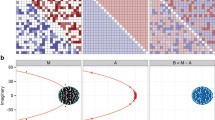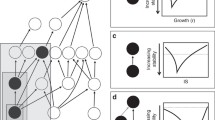Abstract
The cascade model is a standard model for food web data. This article describes a method for testing the cascade model that complements existing tests. Like existing tests, the new test is conditional on the number of links observed in the predation matrix. One important feature of the cascade model is that an ordering of species is required, but in practice the true order is unknown. This feature has important implications for tests of the model, both for the new test and for existing tests. The analysis here does not require a single assumed order. Some real food webs are used for illustration.
Similar content being viewed by others
References
Agresti, A., (1992), “A Survey of Exact Inference for Contingency Tables,” Statistical Science, 7, 131–177.
Baxter, M.J., (1987), “Testing for Misspecification in Models of Spatial Flows,” Environment and Planning A 19, 1153–1160.
Besag, J. and Clifford, P., (1989), “Generalized Monte Carlo Significance Tests,” Biometrika, 76, 633–642.
Cohen, J.E., Briand, F. and Newman, C.M., (1990), The Structure of Food Webs: Data and Theory Berlin: Springer-Verlag.
Critchlow, R. E., and Stearns, S. C., (1982), “The Structure of Food Webs”, American Naturalist, 120, 478–499.
Diggle, P. J., (1983), Statistical Analysis of Spatial Point Patterns, London: Academic Press.
Gelman, A., Carlin, J. B., Stern, H. S., and Rubin, D. B., (1995), Bayesian Data Analysis London: Chapman and Hall.
Goldwasser, L., and Rough garden, J., (1997), “Sampling Effects and the Estimation of Food Web Properties.” Ecology, 78, 41–54.
Manly, B. F. J., (1997), Randomization, Bootstrap, and Monte Carlo Methods in Biology, London: Chapman and Hall.
McCullagh, P., and Nelder, J. A., (1989), Generalized Linear Models, London: Chapman and Hall.
Neubert, M. G., Blumenshine, S. C., Duplisea, D. E., Jonsson, T., and Rashleigh, B., (2000), “Body Size and Food Web Structure: Testing the Equiprobability Assumption of the Cascade Model,” Oecologia, 123, 241–251.
Pimm, S. L., (1982), Food Webs, London: Chapman and Hall.
Rao, A. R., Jana, R., and Bandyopadhyay, S., (1996), “A Markov Chain Monte Carlo Method for Generating Random (0,1)-Matrices with Given Marginals,” Sankhya A, 58, 225–242.
Ross, S. M., (1997), Simulation, San Diego, CA: Academic Press.
Solow, A. R., (1996), “On the Goodness of Fit of the Cascade Model” Ecology, 77, 1294–1297.
Solow, A. R., and Beet, A. R., (1998), “On Lumping Species in Food Webs,” Ecology, 79, 2013–2018.
Williams, R. J., and Martinez, N. D., (2000), “Simple Rules Yield Complex Food Webs,” Nature, 404, 180–183.
Author information
Authors and Affiliations
Corresponding author
Rights and permissions
About this article
Cite this article
Roberts, J.M. Testing the cascade model for food webs. JABES 8, 196–204 (2003). https://doi.org/10.1198/1085711031544
Received:
Revised:
Issue Date:
DOI: https://doi.org/10.1198/1085711031544




